We offer the innovative scattering seismic technology – Reverse Time Holography (RTH). The RTH is a high-effective state-of-the-art solution for oil & gas prospecting and development including seismic service for horizontal drilling.
RTH technology opens up a new era of seismic exploration based on the concept of only wave scattering in the medium. Traditional reflections, on which seismic exploration has been based in the last 70 years, are in this approach only special cases of in-phase scattering and nothing more.
The RTH approach answers the next Grand Challenge Problems of Seismic:
- Increasing the spatial resolution of seismic attributes, including for support high-precision technology of horizontal drilling
- Improving the quality of seismic data processing and of geologic results without increasing the cost of field work
- Building a ultra-high resolution velocity model using new mathematical approaches and adequate computing resources
- Possibility of direct exploration of hydrocarbon deposits based on joint analysis of seismic and well logging data using artificial intelligence methods
RTH end-to-end technology consists from:
- RTH acquisition system
- RTH processing system
- RTH interpretation system
RTH SUMMARY
- The mathematical basis of the RTH technology is the method of full-wave seismic holography in reversed time (Reverse Time Holography).
- The input information for RTH processing system is seismic data from the RTH acquisition system or conventional 2D/3D medium-fold CDP field data.
- The RTH processing method includes, as a special case, the RTM method and is an alternative to the PSTM, PSDM, FWI, AVO/AVA/AVAZ, Acoustic Inversion, MVA methods.
- The result of HPC RTH processing is an original set of seismic attributes of high spatial resolution, which serve as the basis for further RTH interpretation system.
- The RTH technology is implemented in the form of original HPC parallel data processing programs and well-established RTH-attribute interpretation graphs in the conventional software environment of a geologist-interpreter.
- For the RTH interpretation system needs a well logging data.
- The RTH technology was created in 2017
The list of advantages of the RTH technology
- Representation of the studied geological environment in the form of a set of volumetric cells (voxels) of arbitrary size with the subsequent calculation of the attributes in each cell independently of each other
- The spatial resolution of migration images is 3-6 times higher compared to conventional depth migration before summation
- Velocity tomography with a spatial resolution of up to 1 meter
- Lack of near-surface layer problem
- Stability RTH to sparse regular and sparse irregular seismic systems of sources
- Simultaneous and independent calculation of all known seismic attributes, such as: RTM, AVO, Dip, Opening Angle, azimuthal and spatial scattering anisotropy and even more than 50 new, previously unknown attributes
- Time-dependent 4D Scattering Pattern

RTH-velocity cube
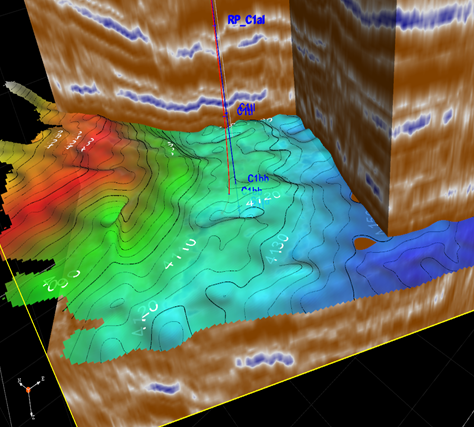
RTH mapping

RTH-velocity, zooming
Forecast of hydrocarbon deposits based on RTH attributes and well logging data
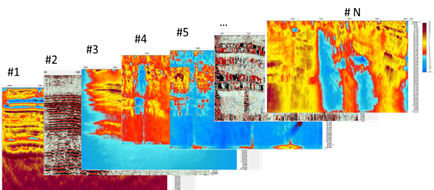
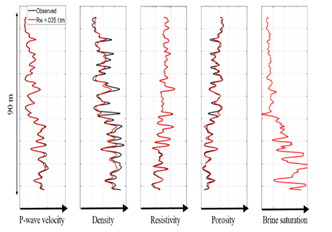

Practical possibilities of the RTH method
Providing seismic comparisons with downhole measurements
- abnormally high pressure zones
- non-structural hydrocarbon deposits
- direct forecast of hydrocarbon deposits
Audit of oil fields with complex geological structure
- identification of decompression zones in target horizons, open fracturing associated with faults
- permeability detection
- identification of areas with improved reservoir properties
- 4D seismic monitoring
Search for non-structural hydrocarbon deposits
- search for porous-fractured reservoirs
- substitution zone search
Seismic support for horizontal drilling
- building a high spatial resolution velocity model
- identification of areas with enhanced drainage properties
List of the main features of the RTH method
- RTH, unlike conventional RTM solutions, is based on solving a system of differential equations of first-order acoustics in pressures and velocities
- Initial Velocity Model in RTH – Arbitrary Piecewise Gradient Continuous Function of Spatial Variables
- In the RTH method, the “synthesis” operator maps the VDCIG data space to the seismic attribute space and is a formal generalization of the “Imaging Condition” image function that is used in all RTM variants.
- RTH is based on the analysis of total scattering vector diagrams depending on time at each point in space. In other words, the RTH scattering index is not only a function of spatial angles, but also of time.
- The RTH method is focused on revealing the spatiotemporal anisotropy of total scattering at each point of the medium. The traditional reflection boundaries in the RTH paradigm are interpreted only as an effect of “in-phase scattering”
- In contrast to RTM, the RTH method analyzes not the angles averaged over the ensemble between the incident (reference) and scattered waves and their amplitudes, but rather the detailed mutual position of two vectors at each moment of time for each source.
- The RTH method includes, as a special case, the RTM method and is an alternative to the PSTM, PSDM, FWI, AVO/AVA/AVAZ, Acoustic Inversion, MVA methods.
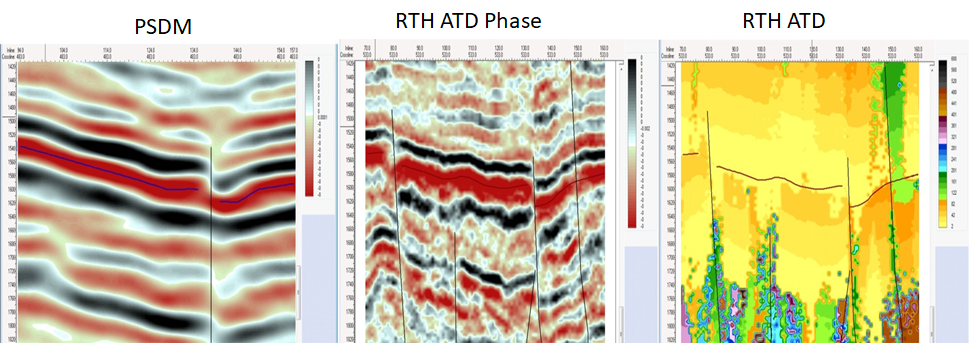
Comparison of PSDM and RTH
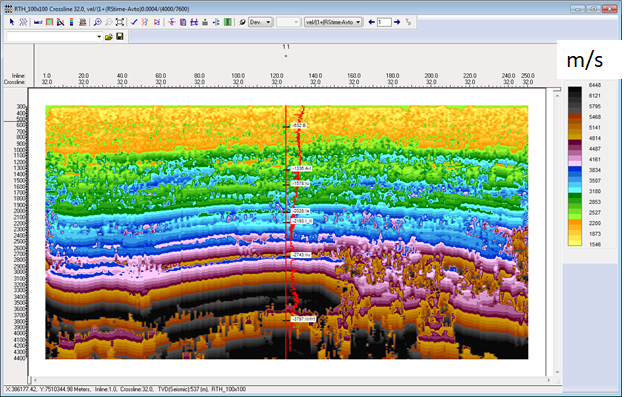
RTH velocity (m/s)

RTH Reverse Time Migration